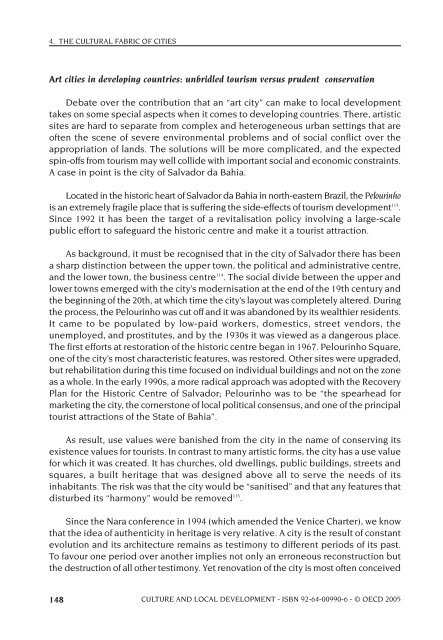OECD Culture and Local Development.pdf - PACA
OECD Culture and Local Development.pdf - PACA
OECD Culture and Local Development.pdf - PACA
You also want an ePaper? Increase the reach of your titles
YUMPU automatically turns print PDFs into web optimized ePapers that Google loves.
4. THE CULTURAL FABRIC OF CITIES<br />
Art cities in developing countries: unbridled tourism versus prudent conservation<br />
Debate over the contribution that an “art city” can make to local development<br />
takes on some special aspects when it comes to developing countries. There, artistic<br />
sites are hard to separate from complex <strong>and</strong> heterogeneous urban settings that are<br />
often the scene of severe environmental problems <strong>and</strong> of social conflict over the<br />
appropriation of l<strong>and</strong>s. The solutions will be more complicated, <strong>and</strong> the expected<br />
spin-offs from tourism may well collide with important social <strong>and</strong> economic constraints.<br />
A case in point is the city of Salvador da Bahia.<br />
Located in the historic heart of Salvador da Bahia in north-eastern Brazil, the Pelourinho<br />
is an extremely fragile place that is suffering the side-effects of tourism development 113 .<br />
Since 1992 it has been the target of a revitalisation policy involving a large-scale<br />
public effort to safeguard the historic centre <strong>and</strong> make it a tourist attraction.<br />
As background, it must be recognised that in the city of Salvador there has been<br />
a sharp distinction between the upper town, the political <strong>and</strong> administrative centre,<br />
<strong>and</strong> the lower town, the business centre 114 . The social divide between the upper <strong>and</strong><br />
lower towns emerged with the city’s modernisation at the end of the 19th century <strong>and</strong><br />
the beginning of the 20th, at which time the city’s layout was completely altered. During<br />
the process, the Pelourinho was cut off <strong>and</strong> it was ab<strong>and</strong>oned by its wealthier residents.<br />
It came to be populated by low-paid workers, domestics, street vendors, the<br />
unemployed, <strong>and</strong> prostitutes, <strong>and</strong> by the 1930s it was viewed as a dangerous place.<br />
The first efforts at restoration of the historic centre began in 1967. Pelourinho Square,<br />
one of the city’s most characteristic features, was restored. Other sites were upgraded,<br />
but rehabilitation during this time focused on individual buildings <strong>and</strong> not on the zone<br />
as a whole. In the early 1990s, a more radical approach was adopted with the Recovery<br />
Plan for the Historic Centre of Salvador; Pelourinho was to be “the spearhead for<br />
marketing the city, the cornerstone of local political consensus, <strong>and</strong> one of the principal<br />
tourist attractions of the State of Bahia”.<br />
As result, use values were banished from the city in the name of conserving its<br />
existence values for tourists. In contrast to many artistic forms, the city has a use value<br />
for which it was created. It has churches, old dwellings, public buildings, streets <strong>and</strong><br />
squares, a built heritage that was designed above all to serve the needs of its<br />
inhabitants. The risk was that the city would be “sanitised” <strong>and</strong> that any features that<br />
disturbed its “harmony” would be removed 115 .<br />
Since the Nara conference in 1994 (which amended the Venice Charter), we know<br />
that the idea of authenticity in heritage is very relative. A city is the result of constant<br />
evolution <strong>and</strong> its architecture remains as testimony to different periods of its past.<br />
To favour one period over another implies not only an erroneous reconstruction but<br />
the destruction of all other testimony. Yet renovation of the city is most often conceived<br />
148 CULTURE AND LOCAL DEVELOPMENT - ISBN 92-64-00990-6 - © <strong>OECD</strong> 2005














